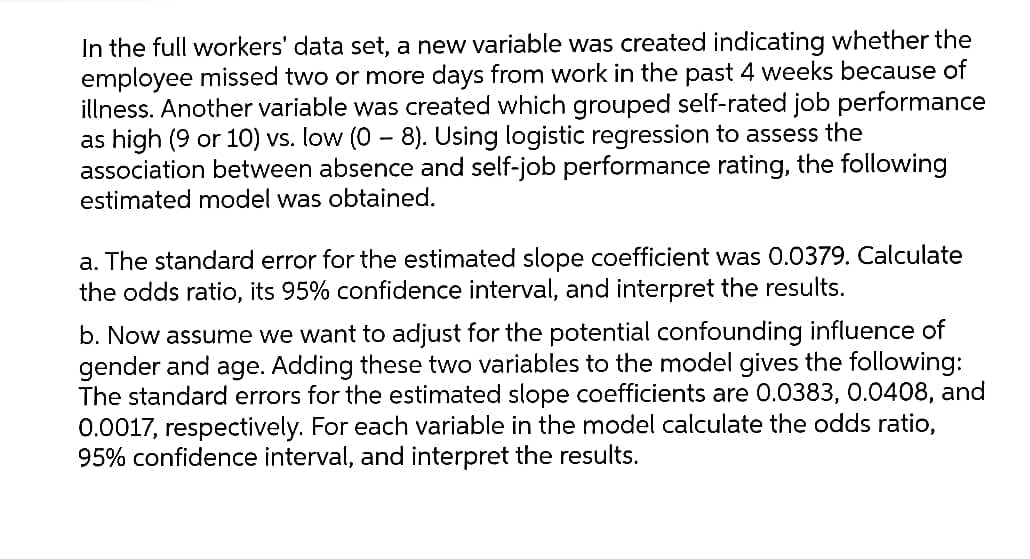In the full workers' data set, a new variable was created indicating whether the employee missed two or more days from work in the past 4 weeks because of illness. Another variable was created which grouped self-rated job performance as high (9 or 10) vs. low (0 – 8). Using logistic regression to assess the association between absence and self-job performance rating, the following estimated model was obtained. a. The standard error for the estimated slope coefficient was 0.0379. Calculate the odds ratio, its 95% confidence interval, and interpret the results. b. Now assume we want to adjust for the potential confounding influence of gender and age. Adding these two variables to the model gives the following: The standard errors for the estimated slope coefficients are 0.0383, 0.0408, anc 0.0017, respectively. For each variable in the model calculate the odds ratio, 95% confidence interval, and interpret the results.
In the full workers' data set, a new variable was created indicating whether the employee missed two or more days from work in the past 4 weeks because of illness. Another variable was created which grouped self-rated job performance as high (9 or 10) vs. low (0 – 8). Using logistic regression to assess the association between absence and self-job performance rating, the following estimated model was obtained. a. The standard error for the estimated slope coefficient was 0.0379. Calculate the odds ratio, its 95% confidence interval, and interpret the results. b. Now assume we want to adjust for the potential confounding influence of gender and age. Adding these two variables to the model gives the following: The standard errors for the estimated slope coefficients are 0.0383, 0.0408, anc 0.0017, respectively. For each variable in the model calculate the odds ratio, 95% confidence interval, and interpret the results.
College Algebra
7th Edition
ISBN:9781305115545
Author:James Stewart, Lothar Redlin, Saleem Watson
Publisher:James Stewart, Lothar Redlin, Saleem Watson
Chapter1: Equations And Graphs
Section: Chapter Questions
Problem 10T: Olympic Pole Vault The graph in Figure 7 indicates that in recent years the winning Olympic men’s...
Related questions
Question
please solve it quickly for multiple vote

Transcribed Image Text:In the full workers' data set, a new variable was created indicating whether the
employee missed two or more days from work in the past 4 weeks because of
illness. Another variable was created which grouped self-rated job performance
as high (9 or 10) vs. low (0 - 8). Using logistic regression to assess the
association between absence and self-job performance rating, the following
estimated model was obtained.
a. The standard error for the estimated slope coefficient was 0.0379. Calculate
the odds ratio, its 95% confidence interval, and interpret the results.
b. Now assume we want to adjust for the potential confounding influence of
gender and age. Adding these two variables to the model gives the following:
The standard errors for the estimated slope coefficients are 0.0383, 0.0408, and
0.0017, respectively. For each variable in the model calculate the odds ratio,
95% confidence interval, and interpret the results.
Expert Solution
This question has been solved!
Explore an expertly crafted, step-by-step solution for a thorough understanding of key concepts.
This is a popular solution!
Trending now
This is a popular solution!
Step by step
Solved in 3 steps

Recommended textbooks for you

College Algebra
Algebra
ISBN:
9781305115545
Author:
James Stewart, Lothar Redlin, Saleem Watson
Publisher:
Cengage Learning

Linear Algebra: A Modern Introduction
Algebra
ISBN:
9781285463247
Author:
David Poole
Publisher:
Cengage Learning


College Algebra
Algebra
ISBN:
9781305115545
Author:
James Stewart, Lothar Redlin, Saleem Watson
Publisher:
Cengage Learning

Linear Algebra: A Modern Introduction
Algebra
ISBN:
9781285463247
Author:
David Poole
Publisher:
Cengage Learning


Algebra & Trigonometry with Analytic Geometry
Algebra
ISBN:
9781133382119
Author:
Swokowski
Publisher:
Cengage

Glencoe Algebra 1, Student Edition, 9780079039897…
Algebra
ISBN:
9780079039897
Author:
Carter
Publisher:
McGraw Hill